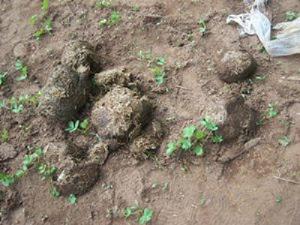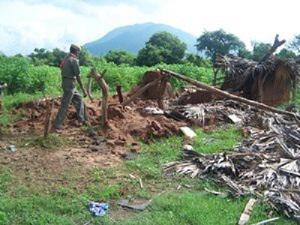Christi Sylvia Thilagar
Recent recolonization of Asian Elephants in the southern Eastern Ghats, after a gap of about 300 years, has led to an increasing number of human-elephant conflicts. The project aims to study this subpopulation of the Asian Elephant in southern Eastern Ghats with emphasis on their habitat use and movement patterns.

Elephant dung, indirect evidence.
Some populations of Asian Elephants from the Western Ghats are known to seasonally move into the hill ranges of southern Eastern Ghats, including Shevaroys, Kolli, and Kalrayan Ranges in Tamil Nadu. One of these subpopulations settled in Javadi and Chittoor Hills in southern Eastern Ghats in the mid 1980s. Seasonal movements of these herds in southern Eastern Ghats has caused extensive damage to agricultural crops and properties and is the reason for increasing number of human-elephant conflicts.

Villager's House Damaged by elephants.
There are no systematic studies to ascertain their origin and dispersal patterns as all available information are gathered from anecdotal records maintained by the governmental agencies and media. Long-term management initiatives for such isolated elephant herds require primary data on their status, movements, and habitat use. Information regarding the extent of conflicts and the effect of their re-colonization on the habitat quality of southern Eastern Ghats is lacking. The study aims to achieve these objectives in southern Eastern Ghats in the States of Tamil Nadu and Andhra Pradesh. This will help in understanding the population ecology of Asian elephants and the spatio-temporal patterns of human-elephant conflicts in the region.